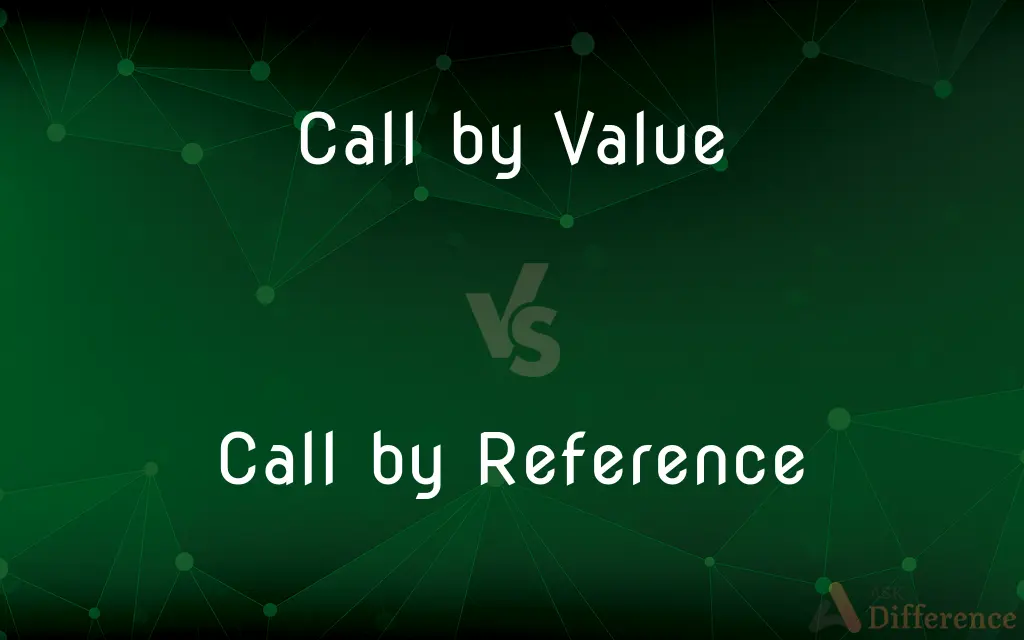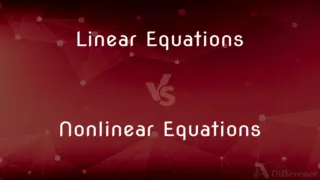Call by Value vs. Call by Reference — What's the Difference?
By Tayyaba Rehman — Published on January 10, 2024
Call by Value sends a copy of the actual parameter's value to the function, while Call by Reference sends the address of the parameter, allowing direct modification.

Difference Between Call by Value and Call by Reference
Table of Contents
ADVERTISEMENT
Key Differences
Call by Value in programming means passing a copy of the value of an argument into a function. Changes made to the argument within the function do not affect the original value. Conversely, Call by Reference passes the argument's address, so modifications within the function affect the original data.
With Call by Value, the function works with a separate copy of the data, ensuring that the original value remains unchanged regardless of the function's operations. In Call by Reference, since the function accesses the data's actual memory address, any changes made within the function are reflected in the original variable.
Call by Value is generally safer as it prevents accidental changes to the original data. However, it can be less efficient for large data structures due to the overhead of copying data. Call by Reference is more efficient for large data as it avoids copying, but it requires careful handling to prevent unintended side effects.
Languages like C++ and Java use both concepts in different contexts. Java uses Call by Value for primitives and Call by Reference for objects. C++ allows the programmer to choose between both, using pointers or references for Call by Reference.
In Call by Value, the function's scope does not affect the original variable. In Call by Reference, variables can be globally affected by the function due to direct memory access, which can be advantageous for certain programming tasks like swapping values or modifying complex data structures.
ADVERTISEMENT
Comparison Chart
Data Handling
Copies the value, creating a separate instance.
Passes the address, referencing the same instance.
Effect on Original Data
No change to the original data.
Changes affect the original data.
Memory Efficiency
Less efficient for large data (due to copying).
More efficient (no copying of data).
Safety
Safer, as it prevents accidental data modification.
Risk of unintended side effects.
Use Cases
Preferred for simple, immutable data.
Useful for large, complex data structures.
Compare with Definitions
Call by Value
It ensures that the original data remains unchanged.
We used Call by Value to protect the original array from changes.
Call by Reference
Changes in the function reflect on the original variable.
The function's modifications were visible in the original object due to Call by Reference.
Call by Value
Call by Value is often used with primitive data types.
Integers and characters in the function are examples of Call by Value.
Call by Reference
It's used for efficient handling of large data structures.
For large objects, we prefer Call by Reference to avoid unnecessary copying.
Call by Value
Call by Value passes a copy of the argument's value to the function.
In Call by Value, modifying a passed integer in the function won't change its original value.
Call by Reference
Call by Reference passes the variable's address, not its value.
Using Call by Reference, we directly modified the array's elements in the function.
Call by Value
It creates a separate memory allocation for the passed value.
Each time the function is called, Call by Value creates a new copy of the variable.
Call by Reference
Call by Reference can lead to unintended modifications.
Accidental changes occurred in the original data due to Call by Reference.
Call by Value
Modifications in the function do not affect the original variable.
Even after altering the value in the function, the original Call by Value parameter remained the same.
Call by Reference
It avoids the overhead of copying large amounts of data.
Call by Reference saved memory by avoiding duplication of the large dataset.
Call by Value
(programming) An evaluation strategy in which the arguments to a function are evaluated first, and the result is passed into the function.
Call by Reference
(programming) An evaluation strategy in which the arguments to a function are evaluated first, and a pointer to the result is passed to the function.
Common Curiosities
What does Call by Reference mean?
Call by Reference involves passing a variable's address, allowing the function to modify the original variable.
In which languages is Call by Value used?
Call by Value is common in languages like Java (for primitive types) and Python.
Are there risks associated with Call by Reference?
Yes, there's a risk of unintended side effects on the original data.
Is Call by Value used in C++?
Yes, C++ uses Call by Value, especially with basic data types.
Is Call by Value safer than Call by Reference?
Yes, because it prevents accidental changes to the original data.
Why is Call by Reference more efficient for large data?
It avoids the memory overhead of copying large amounts of data.
What is Call by Value in programming?
Call by Value means passing a copy of the variable's value to a function.
Can Call by Reference modify the original variable?
Yes, changes in the function directly affect the original variable.
Can Call by Reference improve performance?
Yes, especially in functions dealing with large data structures.
Can Call by Reference be used for all data types?
It can be used for most types, but its suitability depends on the programming language and specific use case.
How does Call by Reference work in C++?
In C++, it involves using pointers or reference variables to pass addresses.
Does Python use Call by Value or Call by Reference?
Python uses a model similar to "Call by Value" for immutable types and "Call by Reference" for mutable types.
Which is better for array manipulation, Call by Value or Call by Reference?
Call by Reference is better for manipulating arrays to avoid copying overhead.
Does Java use Call by Reference?
Java uses a similar concept for objects, but it's technically Call by Value of the object reference.
What happens to the original data in Call by Value?
The original data remains unchanged in Call by Value.
Share Your Discovery

Previous Comparison
CGI vs. Servlet
Next Comparison
Linear Equations vs. Nonlinear EquationsAuthor Spotlight
Written by
Tayyaba RehmanTayyaba Rehman is a distinguished writer, currently serving as a primary contributor to askdifference.com. As a researcher in semantics and etymology, Tayyaba's passion for the complexity of languages and their distinctions has found a perfect home on the platform. Tayyaba delves into the intricacies of language, distinguishing between commonly confused words and phrases, thereby providing clarity for readers worldwide.












































